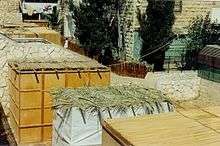Etrog

Etrog (plural: etrogim, Hebrew: אֶתְרוֹג) is the yellow citron or Citrus medica used by Jewish people during the week-long holiday of Sukkot, as one of the four species. Together with a lulav, hadass and aravah, the etrog is to be taken in each Jewish hand.
Taxonomy
| Citron varieties |
|---|
| Acidic-pulp varieties |
| Non-acidic varieties |
| Pulpless varieties |
| Citron Hybrids |
| Related articles |
While in Modern Hebrew etrog is the name for citron of any variety or form, whether kosher for the ritual or not, its English usage applies only to those varieties and specimens used as one of the Four Species. Some taxonomic experts, like Hodgson and others, have mistakenly treated etrog as one specific variety of citron.[1][2] The various Jewish rites utilize different varieties, according to their tradition or the decision of their respective Posek.
Etymology
The romanization as Etrog according to the Sephardic pronunciation, is widely used in Israel through Modern Hebrew. The Ashkenazi pronunciation as in Yiddish, is esrog or esrig. It has been transliterated as Ethrog or Ethrogh in scholarly work, which is according to Yemenite Hebrew.[3] The Hebrew word is thought to derive from the Persian name for the fruit, turung, likely borrowed via Aramaic. [4]
Biblical references
| “ | On the first day you shall take the fruit of majestic trees, branches of palm trees, boughs of leafy trees, and willows of the brook; and you shall rejoice before the Lord your God for seven days. -- Leviticus 23:40, New Revised Standard Version | ” |
Rabbinic Judaism believes the Biblical phrase peri eitz hadar (פְּרִי עֵץ הָדָר) refers to the etrog. Grammatically, the Hebrew phrase is ambiguous; it is typically translated as "fruit of a beautiful tree," but it can also be read as "a beautiful fruit of a tree." Etrogs are carefully selected for the performance of the Sukkot holiday rituals.

.jpg)
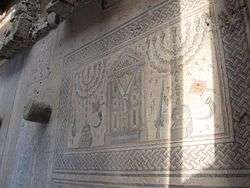


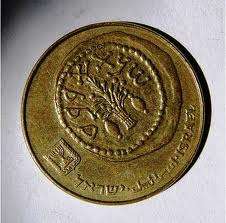
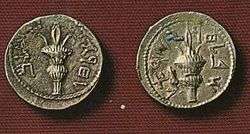
In modern Hebrew, hadar refers to the genus Citrus. Nahmanides (1194 – c. 1270) suggests that the word was the original Hebrew name for the citron. According to him, the word etrog was introduced over time, adapted from the Aramaic. The Arabic name for the citron fruit, itranj (اترنج), mentioned in hadith literature, is also associated with the Hebrew.
Historical cultivation
Etrog have been cultivated in the Holy Land extensively at the times of the Second Temple and is found in many archaeological foundlings of that era. Those include mosaics of Maon Synagogue, Beth Alpha Synagogue, Hamat Tiberias Synagogue and more. In all those cites it is depicted alongside other important religious symbols, like the Shofar or Menorah. It is also found on numerous Bar Kokhba coins.
The earliest reference to etrog in the holy land is still the recent discovery of citron pollen that was found in excavations on the Ramat Rachel site.[5]
Sometime during the first century BCE, Alexander Yanai, the sixth and last of the Maccabean ruler who also appointed himself with the high priesthood, was pelted with the native balady citrons for cheating on the rabbinical interpretation of the mitzva of nisuch hamayim that the priest should have commenced during the Feast of Tabernacles.[6]
In diaspora
After the fall of Jerusalem in 70 CE, exiled Jews planted citron orchards wherever they settled: in Europe (Spain, Greece, and Italy) as well as in North Africa and Asia Minor. Jews who resided in communities north of warm citron-growing areas were dependent on imported etrogim, which caused them much anxiety given the dangers and uncertainties of sea travel. By the seventeenth century some of the most popular sources were the islands of Corsica and Corfu.
Jewish communities in Europe and America then turned to Palestine, where etrog farmers had been marketing etrogim to Europe since the late 1850s through The Fruit of the Goodly Tree Association. Some Jewish communities still preferred citrons from Italy, Greece, Morocco, or Yemen, but many Jews seeking citrons turned to Eretz Yisrael, the land of Israel. These days, American Jews continue to import the majority of their holiday etrogim from Israel, besides during Shmita when there are some halachic problems exporting the produce of Israel.
Cosmetic requirements
Pitam

A pitam or pitom (Hebrew: פיטום) is composed of a style (Hebrew: "דַד" dad), and a stigma (Hebrew: "שׁוֹשַׁנְתָּא" shoshanta), and usually falls off during the growing process. An etrog with an intact pitam is considered especially valuable, but varieties that naturally shed their pitam during growth are also considered kosher. When only the stigma breaks off, even post-harvest, the citron can still be considered kosher as long as part of the style has remained attached. If the whole pitam i.e. the stigma and style, are unnaturally broken off, all the way to the bottom, the etrog is not kosher for ritual use.
Pitam preservation technique
Many more pitams are preserved today due to an auxin discovered by Dr. Eliezer E. Goldschmidt, emeritus professor of horticulture at the Hebrew University. Working with the picloram hormone in a citrus orchard, he unexpectedly discovered that some of the Valencia oranges found nearby had preserved perfect pitams. Citrus fruits, other than an etrog or citron hybrid like the bergamot, usually do not preserve their pitam. On the occasions that they do, their pitams tend to be dry, sunken and very fragile. In this case the pitams were all fresh and solid just like those of the Moroccan or Greek citron varieties. Experimenting with picloram in a laboratory, Goldschmidt eventually found the correct “dose” to achieve the desired effect is one droplet of the chemical in three million drops of water. This invention was highly appreciated by the religious Jewish community.[7]
Purity
In order for a citron to be kosher, it must be neither grafted nor hybridized with any other species. Only a few traditional varieties are therefore used. To ensure that no grafting is used, the plantations are kept under strict rabbinical supervision.
Genetic research
The citron varieties traditionally used as Etrog, are the Diamante Citron from Italy, the Greek Citron, the Balady Citron from Israel, the Moroccan and Yemenite Citrons.
A general DNA study was arranged by the world-renowned researcher of the etrog, Prof. Eliezer E. Goldschmidt and colleagues, who positively testified 12 famous accessions of citron for purity and being genetically related. As they clarify in their joint publication, this is only referring to the genotypic information which could be changed by breeding for e.g. out cross pollination etc., not about grafting which is anyway not suspected to change anything in the genes.[8]
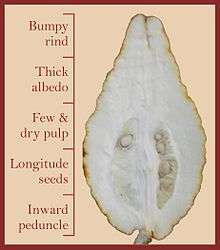
The Fingered and Florentine Citrons although they are also Citron varieties or maybe hybrids, are not used for the ritual. The Corsican Citron was no longer in use, but has recently been reintroduced for ritual use.
Selection and cultivation
In addition to the above, there are many rabbinical indicators to identify pure etrogs out of possible hybrids. Those traditional specifications were preserved by continuous selections accomplished by professional farmers.[9]
The most accepted indicators are as following: 1) a pure etrog has a thick rind, in contrast to its narrow pulp segments which are also almost dry, 2) the outer surface of an etrog fruit is ribbed and warted, and 3) the etrog peduncle is somewhat buried inward; a lemon or different citron hybrid is opposing one or all of the specifications.[10]
A later and not so widely accepted indicator is the orientation of the seed, which should be pointing vertically by an etrog, except if it was strained by its neighbors; by a lemon and hybrids they are positioned horizontally even when there is enough space.[11]
The etrog is typically grown from cuttings that are two to four years old; the tree begins to bear fruit when it is around four years old.[12] If the tree germinates from seeds, it will not fruit for about seven years, and there may be some genetic change to the tree or fruit in the event of seed propagation.[13]
Customs
To protect the etrog during the holiday, it is traditionally wrapped in silky flax fibers and stored in a special box, often made from silver.[14]
After the holiday, eating from the etrog or etrog jam is considered a segula (efficacious remedy) for a woman to have an easy childbirth.[15] A common Ashkenazi custom is to save the etrog until Tu Bishvat and eat it in candied form or as succade, accompanied by prayers that the worshiper will merit a beautiful etrog next Sukkot.[16] Some families make jam or liqueur out of it,[17] or stick cloves in the skin for use as besamim at the havdalah ceremony after Shabbat.
The Dancing Camel Brewery in Tel Aviv, Israel, uses the rinds of etrogim in its annual 'Trog Wit Beer, usually available around the Holiday of Sukkot.[18]
Gallery
 Rabbi Bergman re-examines the Etrog for student
Rabbi Bergman re-examines the Etrog for student Rabbi Dov Landau inspecting an etrog
Rabbi Dov Landau inspecting an etrog Chazon Ish in Bnei Berak market
Chazon Ish in Bnei Berak market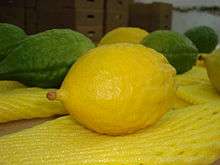 Yanova esrog for sale
Yanova esrog for sale Cross section in Yanover Esrog, to check for genetic purity
Cross section in Yanover Esrog, to check for genetic purity Mature fruit of Yanover Esrog gets to big size
Mature fruit of Yanover Esrog gets to big size Cross section in Braverman Esrog
Cross section in Braverman Esrog- Cross section in Yemenite citron
 Cross section in Ordang Esrog
Cross section in Ordang Esrog- Cross section in Kibilevitz Esrog
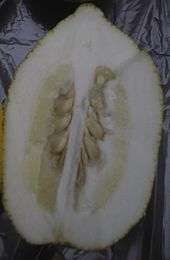 Cross section in a Moroccan
Cross section in a Moroccan- Yemenite citron (left) and a Chazon Ish (right)
.jpg) Cross section in variety etrog citron, and in Fingered citron.
Cross section in variety etrog citron, and in Fingered citron.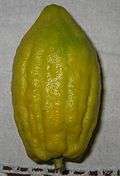 Yanover Esrog without Pitam
Yanover Esrog without Pitam Yanover Esrog with Pitam
Yanover Esrog with Pitam Inspecting an Etrog for flaws
Inspecting an Etrog for flaws Inspecting a Yemenite citron
Inspecting a Yemenite citron- Young plants in Kefar Chabad
- Yemenite citron on tree
 Etrog covered with clove
Etrog covered with clove Pitam perceptive
Pitam perceptive Etrog Blossom
Etrog Blossom Etrog tree from Jewish Encyclopedia
Etrog tree from Jewish Encyclopedia_-_An_Etrog.jpg) Man in Mea Shearim inspecting etrog
Man in Mea Shearim inspecting etrog- Moroccan etrog with prominent Gartel
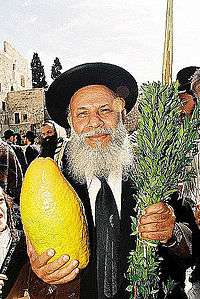 At Western wall
At Western wall German painting
German painting_-_Bnei_Brak.jpg) Two Hasidim in Bnei Berak
Two Hasidim in Bnei Berak_-_P.M._Benjamin_Netanyahu.jpg)
 Old photo of grower
Old photo of grower An etrog from many angles
An etrog from many angles Round silver Etrog box
Round silver Etrog box- Etrog with half-dried Pitam
 Etrog plants in nursery
Etrog plants in nursery Etrog leaves
Etrog leaves- Citron (etrog) flowers
See also
- Photo gallery of citron types not used as Etrogs
- Photo gallery of Fingered citrons
- Uzi-Eli Hezi
- Citrus taxonomy
References
- ↑ Nahon, Peter (2015). Les Agrumes d'Intérieur : des variétés historiques aux essais actuels. Fruits oubliés, 63, 16-18
- ↑ Etrog page by the CVC of UCR
- ↑ The Citrus Industry Archived March 8, 2008, at the Wayback Machine.
- ↑ "Jerusalem dig uncovers earliest evidence of local cultivation of etrogs", Haaretz
- ↑ First evidence of the etrog tree in Israel
- ↑ Jerusalem post
- ↑ Style Abscission in the Citron. American Journal of Botany, Vol. 58, no 1. pp. 14-23
- ↑ Search Authentic Citron
- A brief documentation of this study could be found at the Global Citrus Germplasm Network.
- ↑ Article by Professor Goldschmidt, published by Tehumin, summer 5741 (1981), booklet 2, p. 144
- ↑ Letter by rabbi Shmuel Yehuda Katzenellenbogen of Padua midst the 16th century, printed in Teshuvat ha'Remo chapter 126
- ↑ Shiurey Kneseth Hagdola and Olat Shabbat, cited by Magen Avraham, Orach Chaim chapter 648, comment 23
- ↑ Chiri, Alfredo. (2002). Etrog Archived April 4, 2005, at the Wayback Machine.
- ↑ Sunkist Website
- ↑ http://www.reformjudaism.org/saga-citron
- ↑ Weisberg, Chana (2004). Expecting Miracles: Finding meaning and spirituality in pregnancy through Judaism. Urim Publications. p. 134. ISBN 9657108519.
- ↑ Aish
- ↑ Etrog recipes (link no longer valid)
- ↑ 'Trog Wit
Further reading
External links
| Wikimedia Commons has media related to Etrog. |
- The Citrus Variety Collection by the University of California Riverside
- Ancient Treasures and the Dead Sea Scrolls
- Mosaic depicting an etrog
- Lulav, Etrog, Shofar and Menorah, 2nd Cent. CE, Ostia Synagogue
- An antique Hebrew coin depicting an etrog
- Pictures homecitrusgrowers.co.uk
- Evyatar Marienberg and David Carpenter, The Stealing of the ‘Apple of Eve’ from the 13th century Synagogue of Winchester, Henri III Fine Rolls Project, Fine of the Month: December 2011
- A Huge Etrog-looking Citron in Geetha's Kitchen, amazing photos
- Know Your Etrog, website with educational pictures, information how to plant your own tree.
